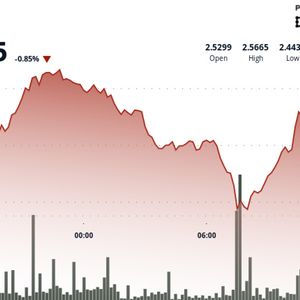DeepSeek AI’s Phenomenal Rise: What You Need to Know About the China AI Chatbot
5 min read
BitcoinWorld DeepSeek AI’s Phenomenal Rise: What You Need to Know About the China AI Chatbot In the fast-paced world of technology, where AI advancements are constantly pushing boundaries, the emergence of new players can send ripples across industries, including the crypto space which often intersects with cutting-edge tech. One such player making waves recently is DeepSeek AI . This Chinese AI lab has burst onto the global scene, gaining viral attention and sparking discussions about the future of artificial intelligence. What is DeepSeek AI and Where Did it Come From? DeepSeek AI quickly rose to prominence, topping app store charts and capturing the attention of analysts and technologists alike. Its rapid ascent has led many to question the current global AI landscape and the dynamics of the AI race. But what exactly is DeepSeek, and how did a relatively new player achieve such widespread recognition? The origins of DeepSeek AI are tied to the financial world. It is backed by High-Flyer Capital Management, a quantitative hedge fund based in China that leverages AI for its trading strategies. Founded in 2015 by AI enthusiast Liang Wenfeng, High-Flyer Capital Management established DeepSeek in 2023 as a dedicated AI research lab, separate from its core financial operations. The lab eventually spun off into its own entity, retaining the name DeepSeek, with High-Flyer as a key investor. From its inception, DeepSeek invested in building its own data center infrastructure for model training. However, like other AI companies in China, DeepSeek has faced challenges due to U.S. export restrictions on advanced hardware. This has meant using chips like the Nvidia H800, a less powerful alternative to the H100 available elsewhere, for training some of its larger AI Models . The DeepSeek team is notable for its composition, reportedly featuring a young technical staff aggressively recruited from top Chinese universities. The company also hires individuals from non-computer science backgrounds to enhance its models’ understanding across diverse subjects, aiming to build a more versatile AI Chatbot . Exploring DeepSeek’s Powerful AI Models DeepSeek first unveiled its suite of AI Models in November 2023, including DeepSeek Coder, DeepSeek LLM, and DeepSeek Chat. However, it was the release of the next-generation DeepSeek-V2 family of models that truly captured the AI industry’s attention. Key characteristics of DeepSeek-V2: A general-purpose system capable of analyzing both text and images. Strong performance across various AI benchmarks. Significantly lower operational costs compared to contemporary models. Forced domestic competitors like ByteDance and Alibaba to reduce their own model pricing, with some even becoming free. The launch of DeepSeek-V3 in December 2024 further solidified DeepSeek’s reputation. According to the company’s internal testing, DeepSeek V3 demonstrated performance exceeding both openly available models like Meta’s Llama and closed models accessed via API, such as OpenAI’s GPT-4o. Another impressive model is DeepSeek’s R1 “reasoning” model, released in January. DeepSeek claims R1 performs comparably to OpenAI’s o1 model on key benchmarks. As a reasoning model, R1 incorporates a self-fact-checking mechanism designed to mitigate common AI pitfalls. While reasoning models might take slightly longer to generate responses (seconds to minutes), they tend to be more reliable, particularly in complex domains like physics, science, and mathematics. The Challenges and Controversies of China AI Despite their technical prowess, DeepSeek’s AI Models face specific challenges inherent to being developed in China. They are subject to oversight and benchmarking by China’s internet regulator to ensure they align with “core socialist values.” This regulatory environment impacts the behavior of the AI Chatbot . For instance, the R1 model within the DeepSeek app will not provide answers to sensitive political questions regarding topics like Tiananmen Square or Taiwan’s autonomy. Beyond domestic regulation, DeepSeek has also become a point of contention in the broader geopolitical and industry landscape. In March, traffic to DeepSeek saw significant visits, positioning it strongly, though still far behind giants like ChatGPT in terms of overall user base. However, the company’s disruptive approach and technical claims have not gone unnoticed. DeepSeek’s Disruptive Business Model and Industry Impact One of the most puzzling aspects of DeepSeek AI is its seemingly unconventional business model. The company prices its products and services significantly below market rates, even offering some for free. Despite considerable venture capital interest, DeepSeek is reportedly not seeking external investment. The company attributes this strategy to breakthroughs in efficiency that allow for extreme cost competitiveness, although some experts have questioned these claims. Regardless of the specifics, developers have embraced DeepSeek’s models. While not strictly open source, they are available under permissive licenses allowing commercial use. Platforms like Hugging Face host DeepSeek’s models, with thousands of derivative models created by developers, accumulating millions of downloads. DeepSeek’s success has been described in various ways, from “upending AI” to being potentially “over-hyped.” Its emergence coincided with an 18% drop in Nvidia’s stock price in January and elicited public comments from industry leaders like OpenAI CEO Sam Altman and Meta CEO Mark Zuckerberg, highlighting the competitive pressure and strategic importance of AI infrastructure. However, DeepSeek also faces significant pushback, particularly from governments concerned about data security and potential propaganda. U.S. Commerce department bureaus, New York state, and countries like South Korea have banned DeepSeek on government devices. Microsoft’s Vice Chairman and President also cited data security and propaganda concerns for prohibiting its use by Microsoft employees, despite Microsoft Azure AI Foundry listing DeepSeek as available. OpenAI has gone as far as to label DeepSeek as “state-subsidized” and “state-controlled,” recommending that the U.S. government consider banning its models. Conversely, Nvidia CEO Jensen Huang praised DeepSeek’s “excellent innovation,” noting that reasoning models like R1 are beneficial for Nvidia due to their high compute demands. The Future of DeepSeek AI Predicting the exact future trajectory of DeepSeek AI is challenging. Continued development and improvement of its Generative AI models are likely. However, the increasing scrutiny and potential bans from governments, particularly in the U.S., pose significant obstacles. Reports suggest the U.S. government is likely to implement broader bans on DeepSeek for government use, reflecting growing wariness over perceived foreign influence in critical technology sectors. Conclusion DeepSeek AI’s rapid rise from a hedge fund lab to a globally recognized AI Chatbot provider is a testament to its technical innovation and disruptive strategy, particularly its focus on compute-efficient AI Models . It has successfully challenged established players, influenced pricing dynamics, and sparked debate about the global AI race and the role of China AI . While its technical achievements are clear, the company navigates a complex landscape of geopolitical tensions, regulatory constraints, and industry competition, making its future path uncertain but undeniably impactful on the evolution of Generative AI . To learn more about the latest AI market trends , explore our article on key developments shaping AI Models features . This post DeepSeek AI’s Phenomenal Rise: What You Need to Know About the China AI Chatbot first appeared on BitcoinWorld and is written by Editorial Team

Source: Bitcoin World



